Introduction
Flexitarians and reducetarians represent almost half of consumers in many countries, and account for the vast majority of plant-based purchases. In this article we’ll share our top tips for brands and retailers looking to reach this burgeoning market.
Why target flexitarians?
A recent pan-European Union (EU) survey led by ProVeg International found that almost 40% of EU consumers now identify as either flexitarian, vegetarian, pescatarian, or vegan, while in Germany, over 50% of consumers identify as flexitarian.1 A similar trend is evident in the United States (US), where almost half of Americans regularly purchase both dairy and plant-based milk during their weekly shop.2
Although vegans represent less than 4% of total addressable consumers, the number of vegans in Europe has doubled in the past four years. But when you include vegetarians, pescetarians, and flexitarians, the group in total represents about 40% of the population – meaning that over a third of all Europeans no longer view themselves as predominantly meat-eaters.3
Flexitarians represent the demographic that is experiencing the fastest growth, now constituting almost 30% of Europeans, and while they are actively reducing their meat consumption, 57% say they also want to gradually eliminate meat from their diets entirely.4
It’s not just the flexitarian sector that’s shifting away from meat. A substantial 27% of mixed eaters are becoming more open-minded about plant-based alternatives.5
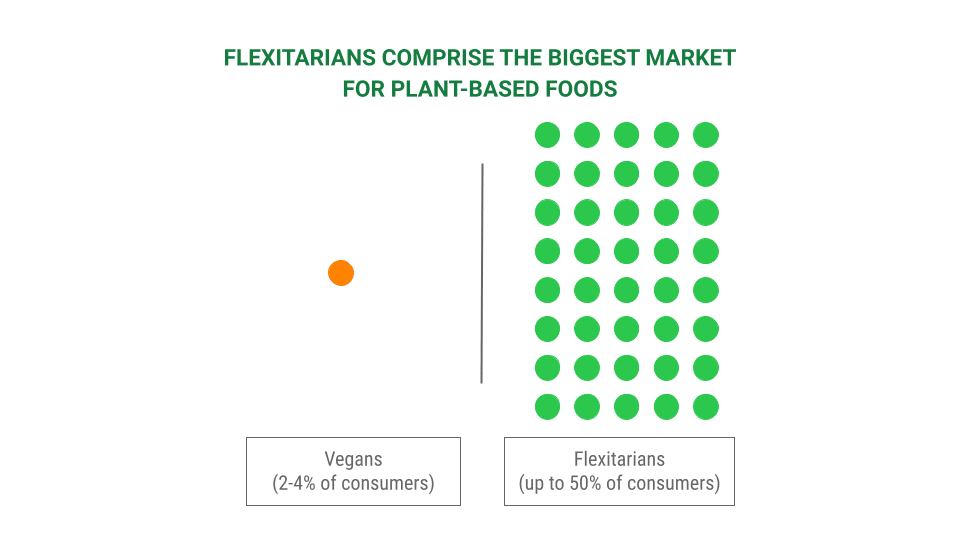
By shifting your marketing focus from vegans to flexitarians, you could unlock a total addressable market that is over 10 times larger!
Research shows that 70% of Beyond Meat’s consumers are flexitarians and that nine out of 10 US consumers who purchase plant-based milk also purchase dairy milk.6
Flexitarian demand for plant-based alternatives isn’t confined to food retail. A recent Google trends analysis from October 2015 to October 2020 showed that general interest in vegan food options is increasing, with Singapore, Sweden, Norway, Denmark, and Finland experiencing the biggest rises.7
Search terms that saw major growth on a global scale included “vegan food near me” (which increased by 2,000% during the five-year period), “vegan café near me” (up 1,500%), and “vegan food options near me” (up 1,250%).8
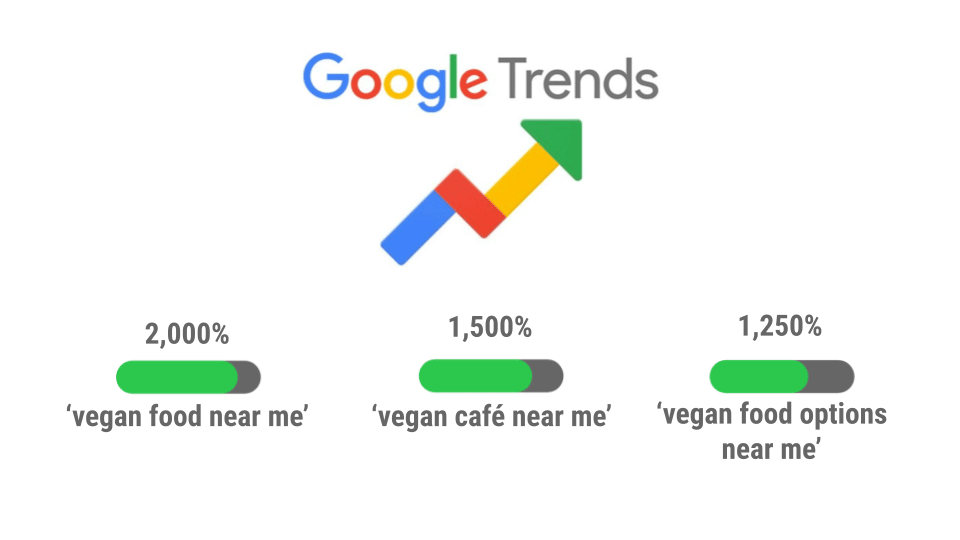
Younger generations, including Millennials and Generation Z, are the driving force behind the explosive growth of the plant-based sector. In general, flexitarians tend to be young women — 55% of US Millennials and 24% of US Gen Z — and they also tend to be educated, well-read, politically liberal, and big users of social media.9
A study by Good Food Institute (GFI) echoes this, finding that purchasers of plant-based products tend to be younger and from higher income brackets than the average consumer.10
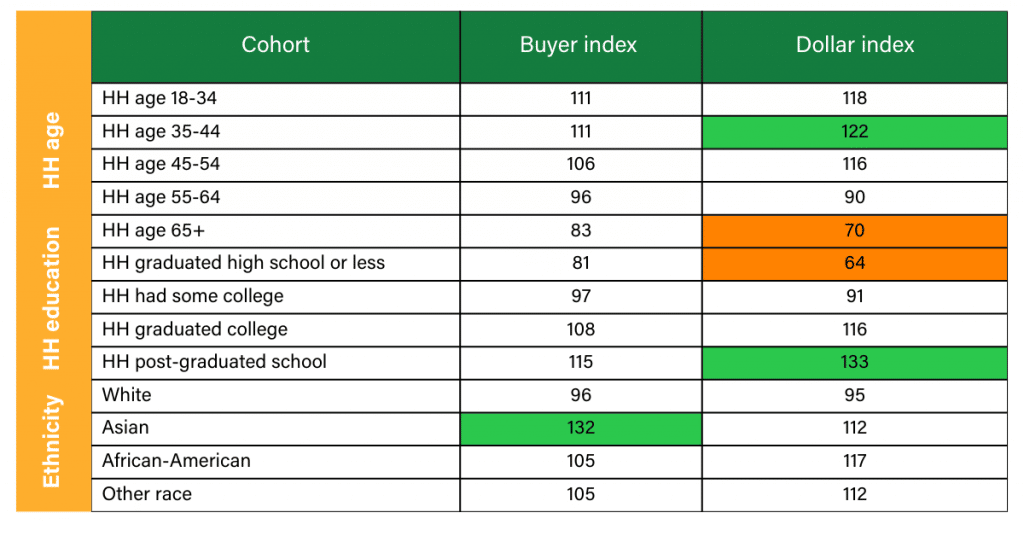
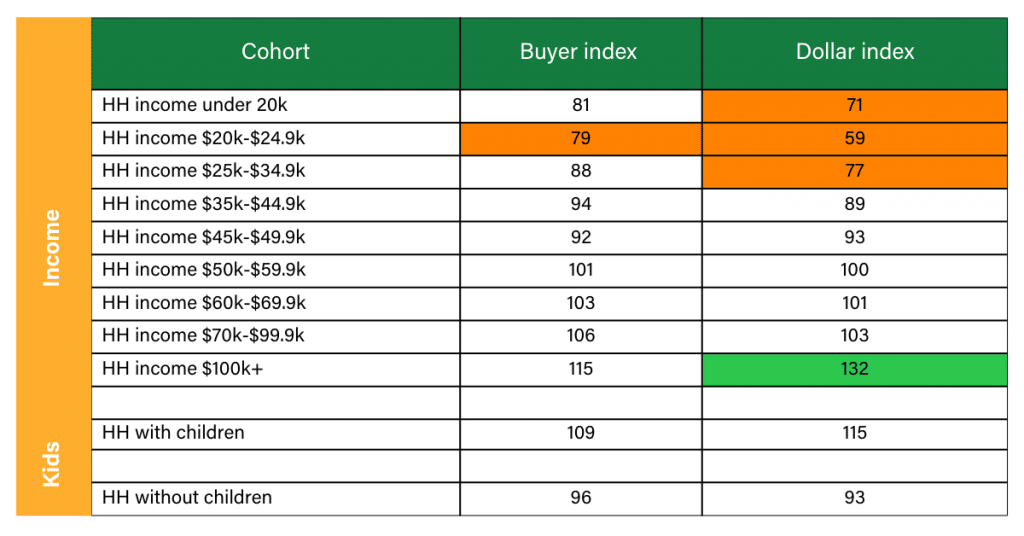
When it comes to Gen-Z consumers, 65% say they want a more ‘plant-forward’ diet, while 79% choose to go meatless once or twice a week. Gen Z consumers are more likely to integrate vegetarian options into their diets without making a decision to go fully vegan or even vegetarian. They see vegan options as just another choice on the menu.11
According to a 2017 report by Mintel, 79% of US Millennials eat meat alternatives, with 30% eating meat alternatives every day and 50% eating meat alternatives a few times a week, behaviors that have likely accelerated over the last four years.12
In a recent study conducted by ProVeg as part of the Smart Protein Project, we asked flexitarians across 11 European countries about the most important factors when choosing a plant-based food product. The results show that taste and health are the most significant purchase drivers – around 2,000 of the 7,500 flexitarians that were surveyed stated that it is important to them that the plant-based food products they choose are tasty and healthy.13
The success of products such as the Beyond Burger and the Impossible Burger shows that consumers want a familiar, craveable experience that’s healthier, more eco-friendly, and animal-free. Food familiarity is key for flexitarians – they might eat a plant burger one night and an animal-based burger the next night.14
Always think about targeting the flexitarian consumer by creating delicious and familiar products that they crave, and showcasing these plant-based menu items with indulgent descriptions integrated seamlessly into the main section of the menu.
Packaging for flexitarians
To target flexitarians, use inclusive artwork that emphasizes traditional values and benefits. This is especially important for analog products such as plant-based sausages or cheeses. For instance, nostalgic images of sunny fields or a photo of a smiling grandmother can be great ways to connect your new plant-based product to a consumer’s previous positive experiences.
Don’t cover your packaging with images of activists and rescue animals. It’s off-putting to your broader target market. As food entrepreneur Heather Mills puts it: “Don’t worry about what vegans like – they will always find you!”15
Flexitarians are looking for taste, convenience, and health (in that order). They don’t want to feel like they’re missing out, so focus on indulgence.
Marketing plays a key role in consumer acceptance. To reach flexitarian consumers, it’s better to promote a vegetarian dish as tasty instead of highlighting that it is vegetarian.”
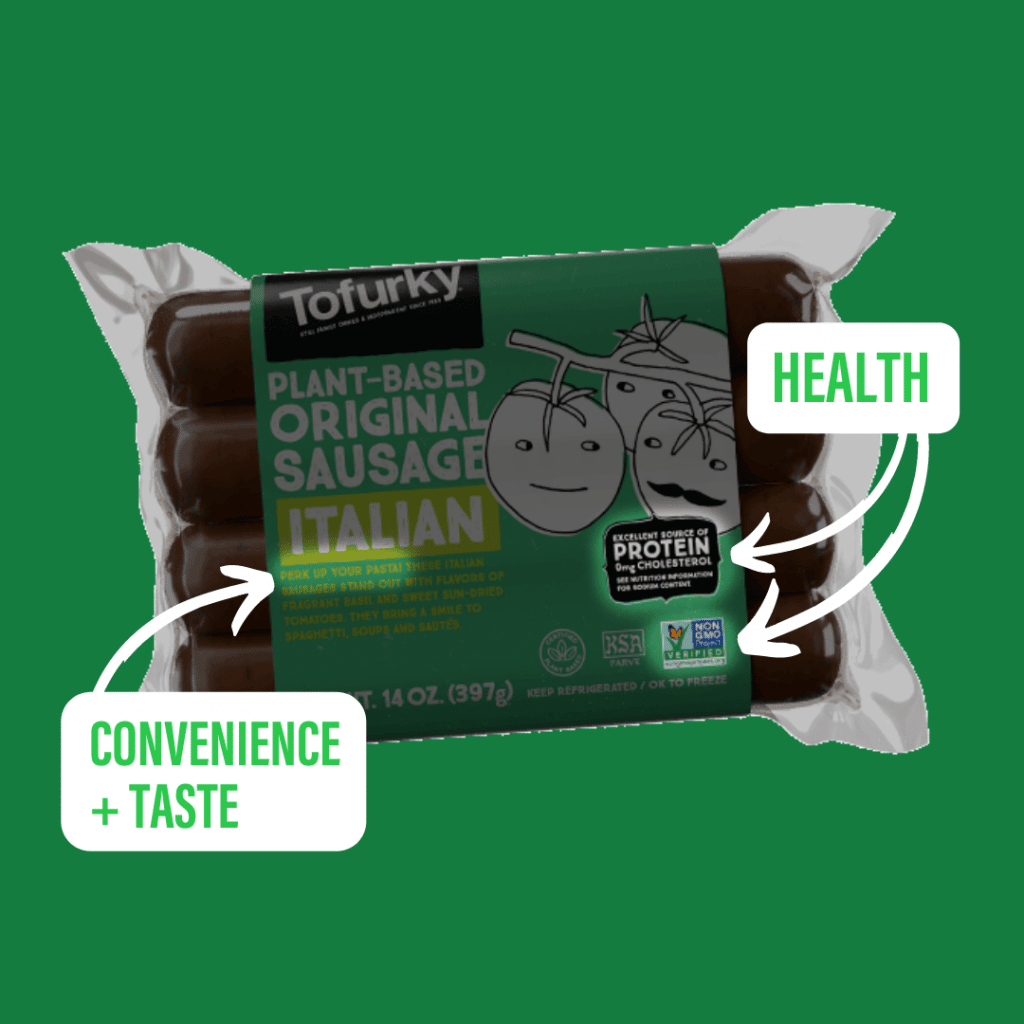
Tofurkey and the Tofoo Co. are two examples of plant-based brands with packaging that ticks all three boxes to attract flexitarian consumers. Tofurky’s Original Italian Sausage packaging foregrounds flavor, use, and health benefits.
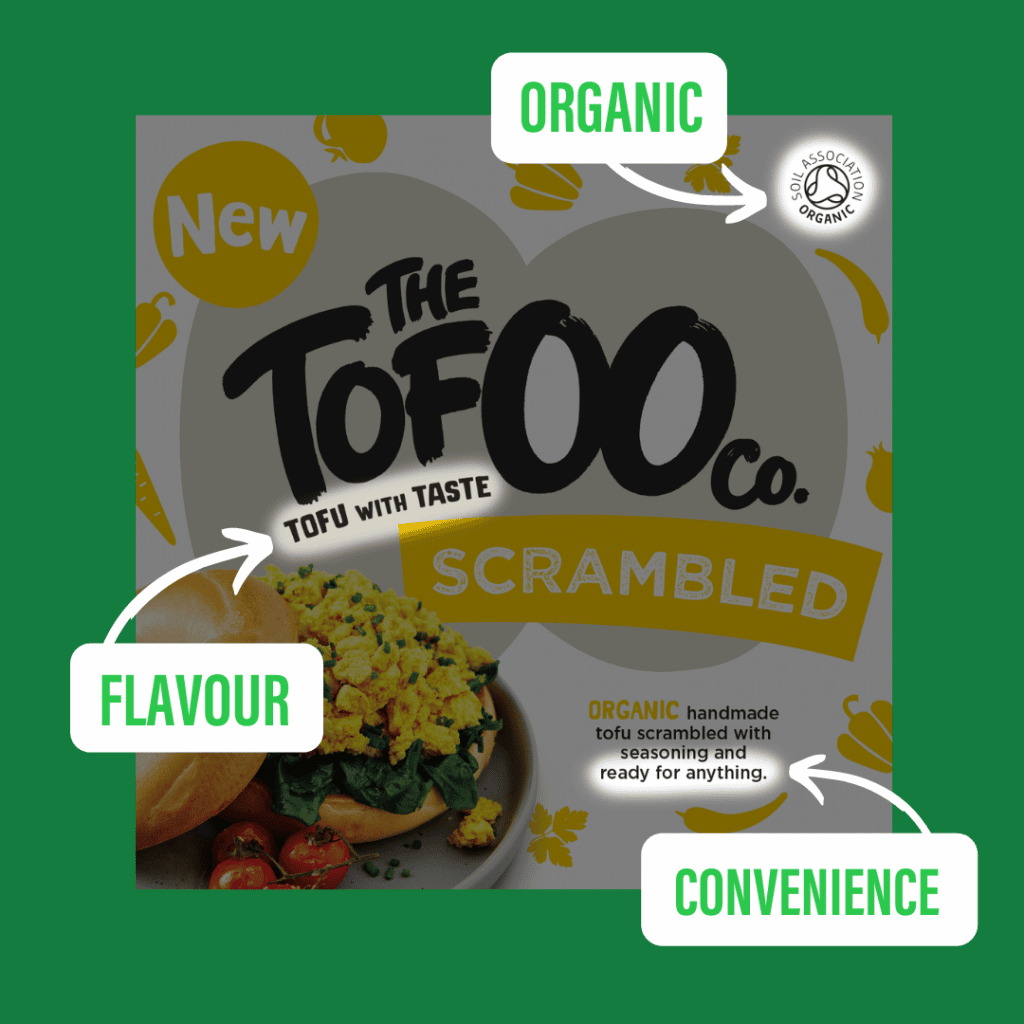
The Tofoo Co.’s Scrambled Tofu packaging covers all three of the top criteria for flexitarian shoppers. The packaging artwork subtly features accompanying vegetable items that complement the product. The strapline “scrambled” is accompanied by a photo of the end product, showing buyers that it’s easy to use. This is further reinforced by the description, which tells you it’s pre-scrambled, and pre-seasoned. Short of literally spoon-feeding their consumer the meal, they’ve nailed it. This is a product designed with convenience, flavor, and health in one.
Pricing for flexitarians
Despite the huge potential market mentioned above, disproportionately high retail and manufacturer margins are suppressing demand for plant-based products.16
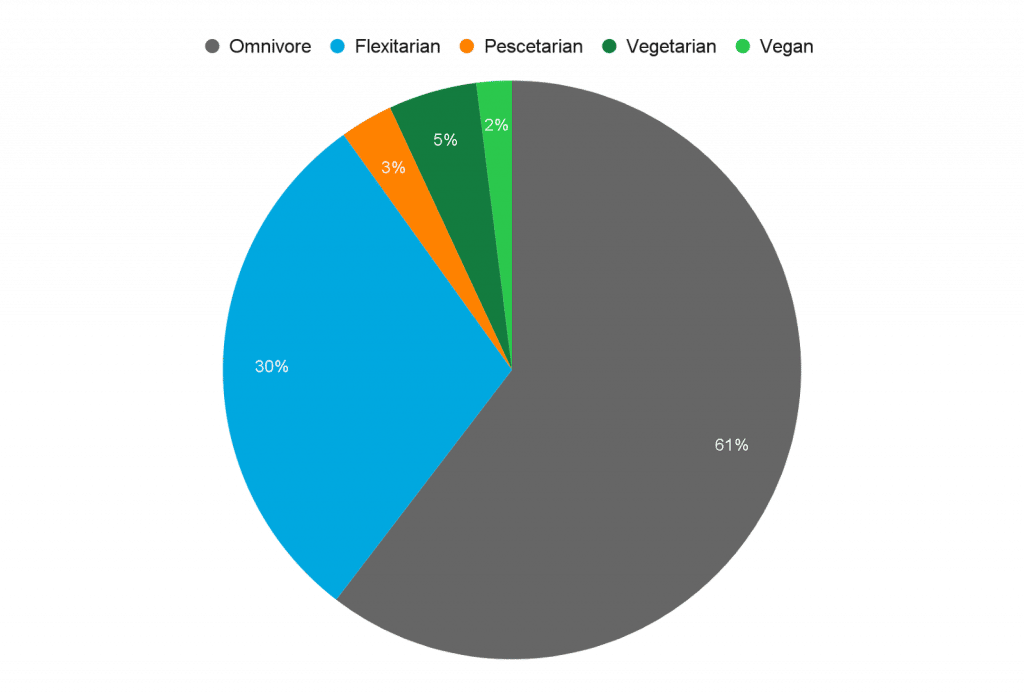
From our research, many retailers and manufacturers charge a 30–40% margin on their plant-based products, compared to just 4–8% on animal-based equivalents. Why? Because historically, the small vegan segment of consumers has been willing to pay a high price for their values.
According to one European retail giant we spoke to, vegans account for just 2% of its customers but 20% of its revenue. At first glance, that sounds like they’re onto a lucrative winner. But when you look at the flexitarian market they’re not addressing, you see that their strategy is actually limiting overall revenue.
ProVeg spoke to a number of manufacturers working on behalf of retailers and brands. These manufacturers are calling on their business clients to lower their margins in order to make plant-based alternatives more accessible to mainstream consumers. “We push our private-label customers not to charge too high on the main market,” explains Frank Giezen, co-founder of major European manufacturer Ojah, speaking with ProVeg. “This indirectly puts pressure on the brands to lower their prices too.”
Mainstream consumers are time-poor and overloaded with decision fatigue. Price is their number-one motivator and the best way to get their attention.
By reducing margins and lowering prices, you can attract more of the flexitarian mass market. This will drive turnover and increase your overall revenue. Let’s take a look at some examples.
Revenue examples: targeting flexitarians vs vegans
The example below shows the revenues that a food producer could expect on plant-based burger patties that they sell to supermarkets for €1.
Let’s say that 1,000 average consumers go to a supermarket. Based on the survey ranges outlined earlier, you could reasonably expect 4% to be vegan, and around 40% to be flexitarian (when you include the vegans, vegetarians, and pescetarians in this second group).18 Even with drastically lower margins, you can see from the table below that the high-volume flexitarian market has the potential to drive two-and-a-half times more profit for manufacturers.
Manufacturer example:
| Manufacturer price per unit | Manufacturer revenue per unit | Total addressable market | Profit per 1,000 average customers | ||
|---|---|---|---|---|---|
| Vegans | High margin (30%) | €1.00 | €0.30 | 4% of shoppers | = €12 profit |
| Flexitarians (and others avoiding animal products) | Low margin (7%) | €1.00 | €0.07 | 40% of shoppers | = €28 profit |
Retailer example:
This next table shows the retail prices and margins for branded burgers sold in Europe. The top two rows are based on current market practices, while the bottom row is ProVeg’s recommendation, which market leaders are now adopting.
| Scenario | Branded burger type | Retail price scenario | Retailer margin (%) | Retailer margin (€) | Primary target consumer | Total addressable market | Profit per 1,000 typical customers |
|---|---|---|---|---|---|---|---|
| Current retail practice | Animal-based | €2.99 | 7% | €0.21 | Mixed-eaters | 90% of shoppers | €189 |
| Current retail practice | Plant-based | €5.99 | 30% | €1.80 | Vegans | 4% of shoppers | €72 |
| ProVeg’s recommendation | Plant-based | €4,99 | 15% | €0.75 | Flexitarians | 40% of shoppers | €299 |
Many retailers are still charging high margins of 30% on branded plant-burgers (see row two). This delivers a high return per unit, but pushes the retail price up to double that of the animal-based equivalent. This price distortion restricts the product’s appeal to vegans only.
Existing sales data, together with the surveys referenced above, show that mainstream consumers are not willing to pay the same premium prices as vegan consumers. Thus, the total revenue from branded plant-burgers becomes artificially low. Happily, there’s a better way that’s more profitable.
In the bottom row, the same plant-burger is being sold at a lower price. By reducing the retailer margin to 15%, the product’s price becomes accessible to flexitarian consumers. This expands the target market ten-fold.
So how does it compare to animal-based profit? The retailer revenue from 900 typical mixed-eaters would be €189. By contrast, just 400 flexitarian shoppers could generate €192–€299 profit for retailers. By reducing your per-unit margin on branded plant-based products you can unlock the flexitarian mass market and increase overall profits by up to 37%.
For more details on plant-based pricing, check out our article 3 steps to achieve price parity.
Convenience for flexitarians
We’ve already established that flexitarians are the biggest target segment for plant-based products by far. Well, they want convenience. To appeal to them, your product should:
- Mimic traditional products that the consumer is familiar with (e.g. scrambled tofu instead of eggs, ‘no-chicken’ pieces instead of chicken).
- Use cooking methods that match the preparation of the conventional product.
- Use portion sizes tailored to your target segment (e.g. ready meals are usually bought by homes with two people, while whole-cuts are bought by larger families).
- Provide recipe ideas that appeal to flexitarians (emphasizing ease).
- Use packaging that includes a serving suggestion and hints at traditional values.
Implementing these strategies will help you to maximize your product’s appeal among mainstream consumers. You’ll experience higher customer retention rates (no more 30–90% avoidance rates following bad experiences!), as well as lateral sales: as flexitarians adopt new habits and plant-based tastes, they increase their purchases in similar categories.
For case studies and more insights into what convenience means to flexitarian consumers, check out our article Convenience by design.
Merchandising to flexitarians
Plant-based foods can also be a way to reduce food waste – so long as you’re strategic about where you stock them and how you merchandise them.
A study by US retailer Kroger found that integrating plant-based alternatives into conventional-meat aisles increased sales of the former by 23% compared to control stores.19
This is important for two reasons. First, flexitarians are more likely to embrace plant-based alternatives when they’re easy to find. Second, it shows that there’s a strong way to mitigate the perceived risk of stocking plant-based alternatives in the chilled section – with the right positioning, pricing, and marketing, they’ll be a hit, and you need not fear wastage.

According to a production expert from ABP Food Group (Anglo Beef Processors), long-term retailer price discounts are key to allowing people to get used to the taste and texture of plant-based products. As such, retailers need to offer producers long-term heavily discounted trial price points for new ranges. Discounts are a vital part of your broader consumer engagement strategy, which should also include taste samplings in/outside supermarkets and promotions at the end of aisles.

ProVeg Tips
ProVeg has extensive knowledge of flexitarian consumers in Europe, from general preferences to specific consumer sentiments regarding particular product categories. We regularly help retailers and brands with their plant-based merchandising, educational social media, and product development. Get in touch with us at [email protected]
Marketing to flexitarians
The packaging and merchandising techniques we’ve outlined work well when you’ve got a consumer’s attention. But how can brands and retailers make busy flexitarians aware of their plant-based alternatives in the first place?
This is where social-media marketing comes in. You want to raise consumer awareness before their next in-store or online shopping session with you. Using influencers is a great way to grow this awareness.
Heura is a European plant-based brand that uses free influencer collaborations to spread the word about its products.
Connecting with influencers who truly match your brand values can increase your visibility and expand your market reach. You should aim to build meaningful relationships with influencers on social media, then give them some free products to sample. If you’re a good fit, they’ll spread the word about you to their followers.
This will then open the door to further collaborations, such as creating shared recipes or co-hosted launch events. These efforts will cumulatively grow your brand’s audience and market share – with up to 11 times more impact than conventional social-media advertising.20
Most importantly, influencer marketing doesn’t have to break the bank! For detailed examples of brands and retailers who are using these methods to great effect, check out our white paper, How to work with influencers to reach key consumers.
Retaining flexitarians
Veganizing your existing product range can be a great way to improve your product’s health benefits (e.g. zero cholesterol, lower fat), reduce allergens, extend product shelf-life, fulfill your sustainability goals, and access the burgeoning plant-based/reducetarian consumer segment.
If your brand or private label has a classic product range, much of it could be easily veganised by replacing a single animal-based ingredient. Here are the top factors to consider:
- Aim for multi-functional ingredients to keep your ingredient’s label short.
- Prioritize taste and texture in your formulation – work with a tasting and feedback service (like ours) to ensure that your product will be a hit with consumers.
- Use state-of-the art equipment to achieve new results with familiar plant-protein bases.
- Manufacture in a dedicated plant-based facility to ensure cost-effective production and avoid contamination problems.
- Prioritize veganizing your ready meals, baked goods, snacks, and confectionery – these often only have one or two animal ingredients, and constitute a huge commercial white space.
Lessons learned from brands who veganised classic products
For great case studies of brands leading the way, check out our article Lessons learned from brands who veganised classic products
Low risk ranges in plant-based food retail
Up to 90% of plant-based products are purchased by omnivores and flexitarians, with plant-based demand growing across all categories.21 Retailers need to stay ahead of the curve if they want to retain their increasingly health-conscious and environmentally minded consumers.22
For flexitarians and omnivores:
- Provide plant-based alternatives to traditional products in order to ensure broad appeal.
- Focus on indulgence – choose high-quality, plant-based brands.
- Get V-label certifications – this will increase the health appeal of legacy baked products that are ‘accidentally vegan’ and drive reducetarian sales.
For the full list of steps retailers can take to meet plant-based demand while minimizing the risk of wastage, read our whitepaper: Plant-based profit: lucrative low-risk product ranges.
Tips for food services: How to cater to flexitarians
Food services can use proven techniques from behavioral economics to nudge consumers towards more sustainable, plant-rich menu options, while maintaining your bottom line. Here are our top tips:
- Ensure plant-based alternatives are integrated into your menu alongside conventional items — segregating them suppresses sales, but making them prominent increases flexitarian purchases.
- If you have items on display, make sure the plant-based alternatives are next to the conventional versions — and are ideally the same price.
- Be among the market leaders who are already achieving 50% plant-based menus to achieve their sustainability goals and cater to the burgeoning flexitarian segment.
- Think about adding to your menu – consumers don’t want to feel they’re missing out, they want delicious, protein-rich alternatives to dishes they know and love.
- Make single-menu items (e.g. soup of the day) vegan by default.
- Focus on creating protein-rich, plant-based versions of your country’s “power dishes” (i.e. the top 25 dishes familiar to all consumers), to maximize appeal and normalize plant-based eating.
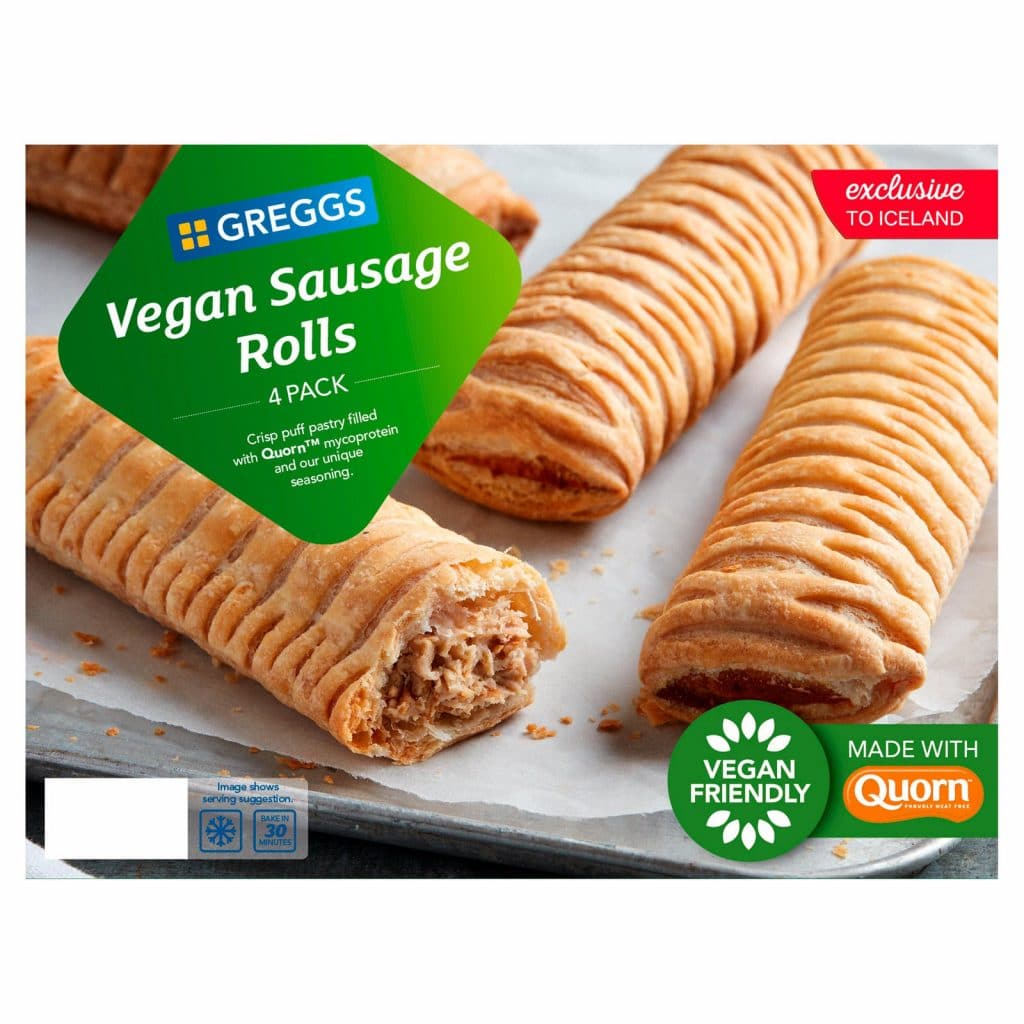
Source: Iceland
- Emphasize the taste and sensory benefits, provenance, traditional identities, and protein content of your plant-based dishes (e.g. instead of a “meat-free sausage”, call it a “classic, spiced Berlin veggie currywurst”).
- Use small symbols on your menu to indicate dishes that are vegan or vegetarian, and consider replacing conventional “V” or “Ve” labels with “PB” (for plant-based) or unobtrusive symbols like a leaf.
- Consider introducing your own plant-based symbol like a green bicep emoji to promote the high protein content of your plant-based dishes.
- For dishes that will continue to contain animal-based ingredients, replace 50% of them with plant-based proteins like lentils – consumers either won’t notice or won’t mind the substitution [CITE].
- Make sure chefs are trained in the possibilities of plant-based foods.
- Ask PB brands if they offer chef training for using their products – many do.
- Make sure your serving staff are 100% clear on the difference between vegan, vegetarian and flexitarian diets, so that they can give quick and informed answers and recommendations to consumers.
- Implement price parity between your conventional and plant-based dishes.
- Partner with brands or wholesalers to achieve economies of scale for newer plant-based proteins like burger patties, sausages, and cheeses, and pass on these price savings to consumers.
- Cap any price premium at 5–10%, otherwise you’ll lose the 30–50% of consumers who are price-sensitive flexitarians and only be left with the 5–10% who are vegan or vegetarian.
- Don’t cut costs by replacing animal-protein with low-protein vegetables. Ensure your plant-based alternatives have comparable protein content, otherwise consumers will feel they’re missing out and will avoid the dish.
Summary
Flexitarians represent the biggest target segment in plant-based food retail. Manufacturers and retailers should focus their marketing, product development, and merchandising efforts on this segment, while ensuring their products are accessible to mainstream consumers’ need for affordable and convenient foods.

ProVeg Tips
Need a hand actioning some of these tips? ProVeg is here to help. Whether you’re launching a new product or want to optimize your existing marketing strategy, ProVeg has you covered. We have an extensive network in Europe in both the B2B and B2C arenas. ProVeg can create a customized marketing and merchandising strategy, or assist with product development and whitespace ideation, to help you reach your goals. Drop us a line at corpo[email protected] to get started.
References
- ProVeg International (2020): European consumer survey on plant-based foods. Available at: https://proveg.com/what-we-do/corporate-engagement/proveg-consumer-survey-report-download/ Accessed 2021-10-08
- Watson, E (2019): 48% of consumers buy plant-based and dairy milks, reveals IPSOS survey. Food Navigator. Available at: https://www.foodnavigator-usa.com/Article/2019/01/24/48-of-consumers-buy-dairy-and-plant-based-milks-reveals-IPSOS-survey# Accessed 2021-10-01
- Smart Protein Project (2021): What consumers want: a survey on European consumer attitudes towards plant-based foods, with a focus on flexitarians’, European Union’s Horizon 2020 research and innovation program (No 862957). Available at: https://smartproteinproject.eu/consumer-attitudes-plant-based-food-report/ Accessed 2021-01-31
- Smart Protein Project (2021): What consumers want: a survey on European consumer attitudes towards plant-based foods, with a focus on flexitarians’, European Union’s Horizon 2020 research and innovation program (No 862957). Available at: https://smartproteinproject.eu/consumer-attitudes-plant-based-food-report/ Accessed 2021-01-31
- Smart Protein Project (2021): What consumers want: a survey on European consumer attitudes towards plant-based foods, with a focus on flexitarians’, European Union’s Horizon 2020 research and innovation program (No 862957). Available at: https://smartproteinproject.eu/consumer-attitudes-plant-based-food-report/ Accessed 2021-01-31
- The Good Food Institute: Plant-Based: The Business Case. Available at: http://goodfoodscorecard.org/why-plant-based/#I1 Accessed 2021-10-19
- Food & Living Vegan (2020): Google searches for ‘vegan food near me’ skyrockets by over 2000%. Available at: https://www.veganfoodandliving.com/news/google-searches-for-vegan-food-near-me-skyrockets-by-over-2000/ Accessed 2021-10-19
- Food & Living Vegan (2020): Google searches for ‘vegan food near me’ skyrockets by over 2000%. Available at: https://www.veganfoodandliving.com/news/google-searches-for-vegan-food-near-me-skyrockets-by-over-2000/ Accessed 2021-10-19
- Mohr, P. (2021): What flexitarians want. FarmProgess. Available at: https://www.farmprogress.com/marketing/what-flexitarians-want Accessed 2021-10-19
- The Good Food Institute (2020): State of the Industry Report. Plant-based meat, eggs, and dairy. Available at: https://gfi.org/wp-content/uploads/2021/05/COR-SOTIR-Plant-based-meat-eggs-and-dairy-2021-0504.pdf Accessed 2021-10-19
- Aramark, cited in Campisi, V (2020): Gen Z’s influential food preferences. The Food Institute. Available at: https://foodinstitute.com/focus/gen-z-preferences/ Accessed 2021-10-19
- Mintel (2017): Protein Report cited in The Good Food Institute: Plant-Based: The Business Case. Available at: http://goodfoodscorecard.org/why-plant-based/#I1 Accessed 2021-10-19
- ProVeg International (2020): European consumer survey on plant-based foods. Available at: https://proveg.com/what-we-do/corporate-engagement/proveg-consumer-survey-report-download/ Accessed 2021-10-08
- The Good Food Institute: Plant-Based: The Business Case. Available at: http://goodfoodscorecard.org/why-plant-based/#I1 Accessed 2021-10-19
- Mills quoted at Plant-Based World Expo, London, October 2021
- Smart Protein Project (2021): What consumers want: a survey on European consumer attitudes towards plant-based foods, with a focus on flexitarians’, European Union’s Horizon 2020 research and innovation program (No 862957). Available at: https://smartproteinproject.eu/consumer-attitudes-plant-based-food-report/ Accessed 2021-01-31
- Smart Protein Project (2021): What consumers want: a survey on European consumer attitudes towards plant-based foods, with a focus on flexitarians’, European Union’s Horizon 2020 research and innovation program (No 862957). Available at: https://smartproteinproject.eu/consumer-attitudes-plant-based-food-report/ Accessed 2021-01-31
- Mascaraque, M. (2020): Going Plant-Based: The Rise of Vegan and Vegetarian Food. EuroMonitor International. Available at: https://go.euromonitor.com/sb-packaged-food-210330-rise-vegan-vegetarian-food.html?utm_source=Pitch&utm_medium=PR&utm_campaign=CT_SB_21_03_30_Rise%20Vegan%20Vegetarian%20Food Accessed 2022-05-09
- Plant-Based Foods Association (2020): Plant-Based Meat Sales Increase an Average of 23% When Sold in the Meat Department. Available at: https://www.plantbasedfoods.org/plant-based-meat-sales-increase-an-average-of-23-when-sold-in-the-meat-department/ Accessed 2022-02-22
- Nielsen Catalina Solutions cited in Carmody, M.: Influencer marketing delivers 11x ROI over all other forms of digital media. Inc. Available at: https://www.inc.com/bill-carmody/influencer-marketing-delivers-11x-roi-over-all-other-forms-of-digital-media.html Accessed 2021-10-21
- The NPD Group cited in Vegconomist (2019): Study Shows 90% of Plant-Based Consumers are Neither Vegetarian Nor Vegan. Available at: https://vegconomist.com/studies-and-numbers/study-shows-90-of-plant-based-consumers-are-neither-vegetarian-nor-vegan/ Accessed 2022-04-07
- Malek, L and Umberger, W. J. (2021): How flexible are flexitarians? Examining diversity in dietary patterns, motivations and future intentions. Cleaner and Responsible Consumption. Available at: http://doi.org/10.1016/j.clrc.2021.100038 Accessed 2021-01-03




